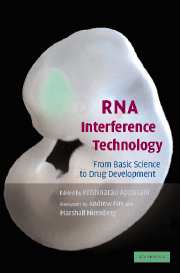Book contents
- Frontmatter
- Contents
- Foreword by Andrew Fire
- Foreword by Marshall Nirenberg
- List of Contributors
- Introduction
- Section one Basic RNAi, siRNA, microRNAs and gene-silencing mechanisms
- Section two Design, synthesis of siRNAs
- Section three Vector development and in vivo, in vitro and in ovo delivery methods
- Section four Gene silencing in model organisms
- Section five Drug target validation
- Section six Therapeutic and drug development
- Section seven High-throughput genome-wide RNAi analysis
- 30 High-throughput RNAi by soaking in Caenorhabtis elegans
- 31 Tools for integrative genomics: Genome-wide RNAi and expression profiling in Drosophila
- 32 Microarray analysis and RNA silencing to determine genes functionally important in mesothelioma
- 33 High-throughput RNA interference
- 34 Generation of highly specific vector-based shRNAi libraries directed against the entire human genome
- Index
- Plate section
- References
33 - High-throughput RNA interference
Published online by Cambridge University Press: 31 July 2009
- Frontmatter
- Contents
- Foreword by Andrew Fire
- Foreword by Marshall Nirenberg
- List of Contributors
- Introduction
- Section one Basic RNAi, siRNA, microRNAs and gene-silencing mechanisms
- Section two Design, synthesis of siRNAs
- Section three Vector development and in vivo, in vitro and in ovo delivery methods
- Section four Gene silencing in model organisms
- Section five Drug target validation
- Section six Therapeutic and drug development
- Section seven High-throughput genome-wide RNAi analysis
- 30 High-throughput RNAi by soaking in Caenorhabtis elegans
- 31 Tools for integrative genomics: Genome-wide RNAi and expression profiling in Drosophila
- 32 Microarray analysis and RNA silencing to determine genes functionally important in mesothelioma
- 33 High-throughput RNA interference
- 34 Generation of highly specific vector-based shRNAi libraries directed against the entire human genome
- Index
- Plate section
- References
Summary
Introduction
RNA interference (RNAi) is an evolutionarily conserved pathway of gene silencing that identifies and destroys mRNA sequences derived from selfish repetitive or viral sequences. The mechanisms and physiologic functions of RNAi pathways are discussed in Section 1. Because RNAi can be triggered by exogenously supplied double-stranded RNA (dsRNA) molecules, in principle one can effectively silence the expression of a gene and infer its physiologic function given its sequence. RNAi analysis on a genome-wide scale is a versatile and powerful tool that holds great promise in functional annotation of the human genome and in acceleration of drug target discovery and validation. The rapid advances to date have illustrated that high-throughput RNAi can complement genetic studies in traditional model organisms to extend our understanding and probe the mechanisms of well-studied pathways. In this chapter, we will focus on emerging methodologies and issues surrounding high-throughput RNAi in mammalian systems, and highlight the potential advances and pitfalls with these new technologies.
Generation of genome-wide RNAi reagents
In order to silence each gene in the genome using RNAi, the first step is to create the appropriate library of dsRNA reagents. In Caenorhabditis elegans and Drosophila melanogaster, long segments of dsRNA are readily taken up by the animal or tissue culture cells, respectively, and genome-wide RNAi libraries can be constructed by annealing complementary RNAs synthesized from both strands of the same cDNA.
- Type
- Chapter
- Information
- RNA Interference TechnologyFrom Basic Science to Drug Development, pp. 470 - 479Publisher: Cambridge University PressPrint publication year: 2005



